| AS MEMBERS OF THE BRITISH ROYAL FAMILY, NICHOLAS "DAGMAR" AND TSARINA ALEXANDRA WERE GUARANTEED A COMFORTABLE RETIREMENT IN ENGLAND OR DENMARK. THE 4 BEAUTIFUL DUCHESSES AND TSAREVICH ALEXIS WERE SENT TO ORTHODOX HEAVEN IN 1918. |
Queen Victoria hated the Russians with a passion, and her burring ambition was to replace the Orthodox Church with the Latin Church.
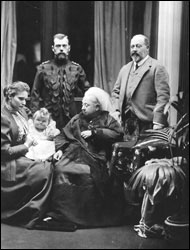 Nicholas "Dagmar" and Queen Victoria at Balmoral Castle, Sept. 1896. |
|
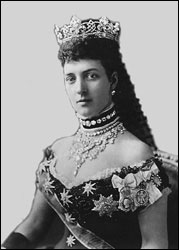 Viking Alexandra of Denmark (1844–1925). |
Princess Alexandra became Queen Alexandra when "Edward the Caresser" became king in 1901. That Viking was also the mother of King George V.
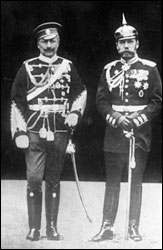
"Kaiser Bill" and Nicholas "Dagmar"
in Berlin in 1905. |
|
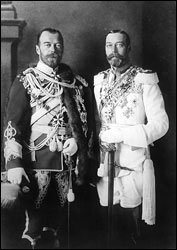
King George V and Nicholas
"Dagmar" in Berlin in 1913. |
Sir George Buchanan was the British ambassador to Orthodox Russia from 1910 to 1917.
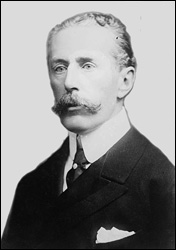 Sir George Buchanan (1854–1924). |
|
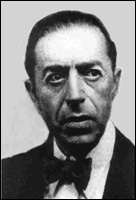 Ace of Spies Sidney Reilly (1873–1925). |
At the beginning of the war on the Eastern Front, Grand Duke Nicholas was overall commander. He was a grandson of Nicholas I and a first cousin of Nicholas "Dagmar."
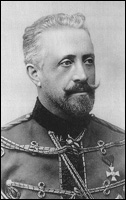 Grand Duke Nicholas (1868–1929). |
|
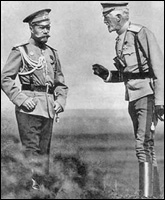 Nicholas "Dagmar" and the Grand Duke discussing strategy. |
Nicholas "Dagmar" had absolutely no military experience whatsoever so his assuming command of the armies was a great gift to his friend the Kaiser.
The 4 Grand Duchesses and Alexis were sent to Orthodoc heaven from Siberia!!
After the February Revolution in 1917, the Tsar signed the official abdication papers on March 15–the Ides of March. Subsequently, the Romanovs were subject to house arrest in their former palace, Tsarskoye Selo, located 24 kilometers (15 km) south of St. Petersburg.
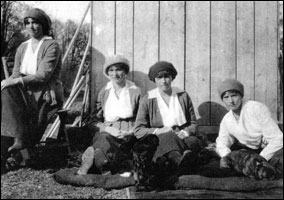 Grand Duchesses, Olga, Tatiana, Anastasia, and Marie in captivity at Tsarskoye Selo. |
|
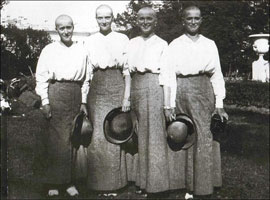 4 bald Grand Duchesses recovering from measles. |
Here is a quote from a biography of "tutor" Pierre Guilliard:
As the Grand-Duchesses were losing all their hair as the result of their illness, their heads have been shaved. When they go out in the park they wear scarves arranged so as to conceal the fact. Just as I was going to take their photographs, at a sign from Olga Nicolaievna they all suddenly removed their headdress. I protested, but they insisted, much amused (Guilliard, Thirteen Years at the Russian Court, p.231).
In August 1917, the Kerensky government evacuated the Romanovs to Tobolsk in the Urals, allegedly to protect them from the rising tide of revolution. There they lived in the former Governor's Mansion in considerable comfort. In October 1917, however, the Bolsheviks seized power from Kerensky's Provisional Government; Nicholas followed the events in October with interest but not yet with alarm.
Romanov
Captivity |
|
| Tsarskoe Selo | March 21, 1917–August 14, 1917 |
| Tobolsk | August 19, 1917– April 26, 1917 |
| Ekaterinburg | April 30, 1918 – July 1918 |
In April 1918, the Romanovs were transferred to the town of Ekaterinburg–about 150 miles (150 km) southwest of Tobolsk. The city was on the direct line of the Trans-Siberian Railroad.
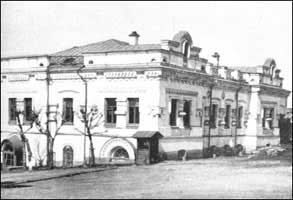 The Ipatiev House in Ekaterinburg circa 1928. |
|
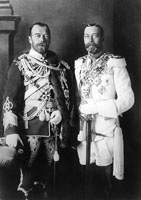 Cousins Georgie and Nicky. |
"Tutor" Charles Sydney Gibbes was in constant contact with the British government. Together with the British ambassador, Sir George Buchanan, he arranged for the Romanovs to "escape" to Britain:
Nor was he alone in expecting to go to England. Upon abdication, Nicholas had made four requests of the Provisional Government: (1) that he be given safe conduct to Tsarskoe Selo; (2) that the family be permitted to stay there until the children were completely recovered; (3) that they be given safe conduct to Murmansk, which implied embarking for England; and (4) that they be permitted to return after the war to take up permanent residence in the Crimea, at Livadia. (Benagh, An Englishman in the Court of the Tsar, p. 148).
From Ekaterinburg, the family traveled by train to Vladivostok, guarded by general Michael Dieterich's soldiers. On the last leg of the journey from Rupert's Land to Britain, their ship was torpedoed by a "German" U-boat. A watery grave meant no bodies as relics, and no heirs to continue the mighty Romanov dynasty.
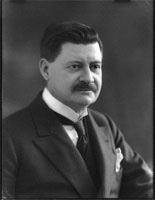 Sir Charles Eliot (1862–1931). |
|
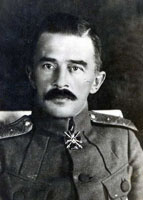 General Mikhail Diterikhs (1874–1937). |
Unfortunately, WWI was still raging and the Atlantic was filled with "German" U-boats. That's the most likely scenario but only MI6 knows exactly where they found a watery grave. Mr. British Empire, Lord Kitchener of Khartoum, who was the driving force behind the war, met a similar fate somewhere in the North Atlantic Ocean.
Very conveniently, general Diterikhs was assigned the task of "investigating" the murders of the Romanovs, and creating the official myth of their demise in the Ipatiev House.The 7 doppelgängers murdered instead of the Romanovs!!
The British Secret Service has always specialized in using doppelgängers or doubles. John Wilkes Booth had a look-alike and Hitler had at least 5 doubles.
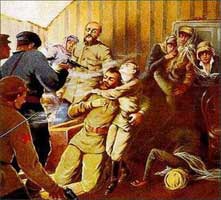 A pictorial of the murder of the "Romanovs" by the Bolsheviks. |
|
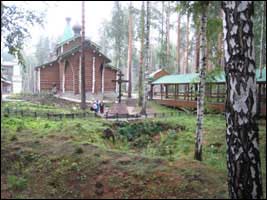 The Open Mine at Four Brothers Monastery. |
It was not until the late 1970's that the bodies were "discovered" but kept secret until the Fall of the Soviet Union. DNA tests were said to prove that they were the bodies of the Romanovs. All DNA proves is that the bones recovered were members of the human race.
The last person to tell the TRUTH about the Romanovs was the Orthodox priest, Father Storozhev, who visited them on July 14, to hold a service in the house:
14 July was a Sunday and that morning Father Storozhev and his deacon had again visited the Romanovs to hold a service. Their report of the visit was to be the last detailed account by outside observers of conditions inside the Ipatiev House. The priests donned their robes in the command post just outside the imperial family's living quarters. Commissar Yurovsky enquired after Storozhev's health and the priest mentioned that he had just had pleurisy. Yurovsky confided that he too had trouble with his lungs. Then they went in to the imperial family. This time Alexei was sitting in an armchair, pale, but not as pale as the priest remembered him from a previous visit. The tsarina looked brighter too. All the family was dressed as before; but there was a noticeable oddity: the emperor looked different–his beard seemed shorter and narrower, as if he had shaved around it. And there was something else. The grand duchesses's hair, which the priest recalled as cut short at the back only six weeks previously, seemed now to have grown right down to their shoulders. According to Storozhev, there was something strange about the service too:Just after the liturgy of the low mass, there's a point where we read the following prayer: "May the souls of the dead rest in peace with the saints." For some reason the deacon, instead of reading it, began to chant. I did the same, a little annoyed by his forgetting the routine, but hardly had we begun than behind me I heard all the members of the family falling on their knees ... As I was leaving, I walked past the grand duchesses, and I heard a faint "thank you". I'm sure I wasn't mistaken. The deacon and I departed in silence. Suddenly, near the School of Fine Arts, the deacon said to me: "Do you know, something has happened to them in there." Since these words expressed my very own thoughts, I stopped and asked him why he thought that. "Yes, definitely, it's as if they were all somehow different. Why, nobody even sang!"The following day, Monday 15 July, Yurovsky sent the little kitchen boy, Leonid Sednev, out of the Ipatiev House to live with the guards across the street. That day also the local labour union sent in four women to clean the floors of the Ipatiev House. The grand duchesses, they said later, seemed very cheerful, and helped them move the beds. (Summers, The File on the Tsar, pp. 49-50).
The little kitchen boy, Leonid Sednev, was about the same age at Tsarevich Alexis. That would make 7 doppelgängers killed to create the legend of the Romanovs perishing in Ekaterinburg.